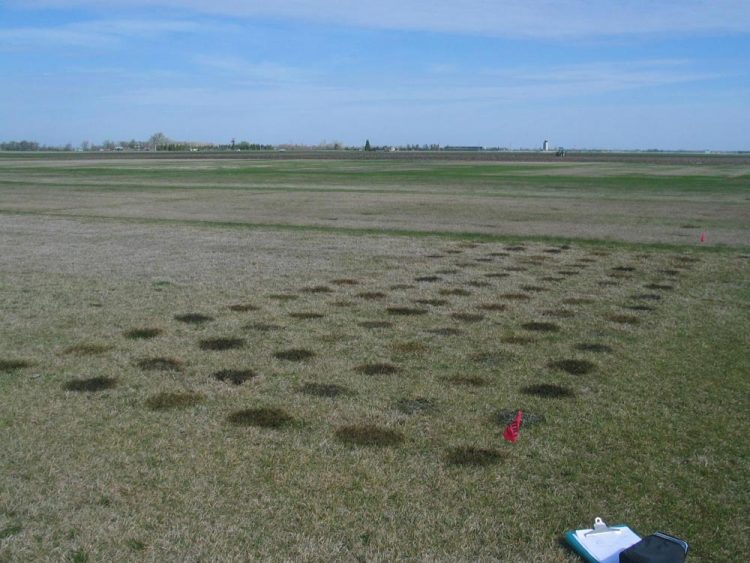Mulching plus remediation corrects contaminated lawns

Researchers applied diesel and hydraulic fluid spill treatments to Kentucky bluegrass plots in spring. Experiments showed that a combination of remediation and mulching treatments sped up perennial ryegrass reestablishment after the spills. Photo courtesy of Deying Li
Petroleum-based spills on turfgrass can occur during lawn care and maintenance, primarily as a result of equipment failure or improper refueling. When these spills happen, hazardous hydrocarbons can contaminate soil and compromise the chemical balance of the grass and soil.
The authors of a study in the June 2016 issue of HortTechnology found that application of mulching materials after soil remediation and reseeding was effective in reestablishing perennial ryegrass in 6 weeks after diesel and hydraulic fluid spills.
“Damage caused by hydrocarbons to turfgrass can be long lasting and difficult to correct due to slow degradation of most hydrocarbons by microbes in soils,” explained Longyi Yuan, Yang Gao, and Deying Li, authors of the research report.
They said that the most effective methods currently used to reclaim soils after petroleum-based spills involve leaching contaminants with detergent water and applying absorbents such as a humic substance and activated charcoal. The scientists investigated how mulching and reseeding could be effective in speeding the reestablishment of turfgrass after petroleum-based spills.
In a 2-year study in field plots established with 'Kenblue' Kentucky bluegrass, the researchers applied diesel and hydraulic fluids at a rate of 15 L·m-2. They then applied two liquid humic amendments and an activated flowable charcoal, with tap water/dishwashing detergent used as a control.
Nitrate nitrogen was added to each remediation treatment to facilitate remediation. Next, the spilled areas were seeded with perennial ryegrass and then three mulching treatments (biochar, peat pellets, and paper pellets) were applied at a thickness of 0.375 inch.
Analyses showed that all remediation methods resulted in better green density of newly seeded perennial ryegrass than the untreated control. “The combination of peat pellets, mulching, and remediation with humic amendment 1 resulted in the best turfgrass green density in the reestablished perennial ryegrass,” the authors said.
While previous remediation experiments using organic amendments alone found that turfgrass reestablishment took more than 4 months, the combination of remediation and mulching treatments in this study allowed for reestablishment of perennial ryegrass in just 6 weeks.
“This study tested perennial ryegrass only,” the authors noted. “However, in a region where cool-season grasses predominate, overseeding with perennial ryegrass immediately after petroleum-based spills to create a grass cover is a practical option. Reseeding with a cool-season grass species conforming to the original lawn in a later stage can then be done if needed.”
###
The complete study and abstract are available on the ASHS HortTechnology electronic journal web site: http://horttech.
Founded in 1903, the American Society for Horticultural Science (ASHS) is the largest organization dedicated to advancing all facets of horticultural research, education, and application. More information at ashs.org
Media Contact
All latest news from the category: Agricultural and Forestry Science
Newest articles

Silicon Carbide Innovation Alliance to drive industrial-scale semiconductor work
Known for its ability to withstand extreme environments and high voltages, silicon carbide (SiC) is a semiconducting material made up of silicon and carbon atoms arranged into crystals that is…

New SPECT/CT technique shows impressive biomarker identification
…offers increased access for prostate cancer patients. A novel SPECT/CT acquisition method can accurately detect radiopharmaceutical biodistribution in a convenient manner for prostate cancer patients, opening the door for more…

How 3D printers can give robots a soft touch
Soft skin coverings and touch sensors have emerged as a promising feature for robots that are both safer and more intuitive for human interaction, but they are expensive and difficult…





















